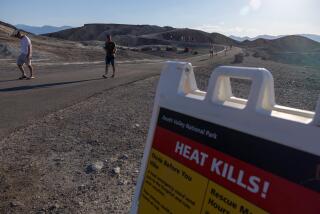Rocking and Rolling on a Day at the ‘Racetrack’
- Share via
Death Valley, the largest national park outside Alaska, has more than its share of unusual features. Badwater, the lowest spot in the Western Hemisphere, and the desert pupfish, thriving against all odds in Salt Creek, are but two of the park’s weird sights.
The rocks scooting across Racetrack Valley may just be the park’s weirdest phenomenon. Although scientists have measured the depth of Badwater and figured out how the pupfish endures, geologists haven’t determined just how rocks move around the Racetrack.
An ancient lake bed, the Racetrack is a 2.5-mile-long, oval-shaped dry mudflat. A rock outcropping at its north end is known as the Grandstand. Rocks of various sizes (baseball to basketball) slide across the old lake bed, leaving tracks. These tracks are straight, curved and even looped, and extend up to 600 feet.
It’s theorized that the rocks slide after rain moistens the top couple of centimeters of the lake bed and a high wind pushes them around. This sounds plausible enough, but it doesn’t explain why they move in such peculiar patterns. Some rocks have made sudden right-angle turns; others have made complete loops and ended up almost exactly where they began.
The rocks are not one of Death Valley’s roadside attractions, so you’ll have to take a short hike to visit them.
Two other hikes complement your day at the Racetrack. Walk a mile along the rim of the volcanic Ubehebe Crater. For grand views of the Racetrack, ascend the trail to Ubehebe Peak. This strenuous path begins at the turnout to the Grandstand, two miles north of the Racetrack trail head. The hike to the 5,658-foot summit (five miles round trip with a 2,000-foot elevation gain) requires some rock scrambling. A more modest 1.5-mile hike up the trail to the ridge crest also delivers great vistas.
Directions to trail head: From the Furnace Creek Visitor Center, drive 17 miles north on California 190, then bear right toward Scotty’s Castle and proceed 32 miles to the Grapevine Ranger Station and entry kiosk. Head north toward Ubehebe Crater for five miles.
The paved road ends with a left turn into the Ubehebe Crater parking lot, but you continue south 20 miles on the washboard-surface, occasionally rough dirt Racetrack Valley Road (suitable for high-clearance passenger cars) to Tea Kettle Junction.
Bear right and travel six more miles to the Grandstand on the left side of the road and two more miles to parking for the Racetrack, identified by a park service interpretive sign on the left.
The hike: Head due east across the old lake bed. Hiking straight across the valley from the sign is the quickest route. A half-mile hike takes you to the first rock tracks. If you keep hiking toward the mountains on the far side of the lake bed, you’ll encounter more rocks. (These mountains supply the sliding rocks.)
Wander at will among the rocks and return the way you came.
(BEGIN TEXT OF INFOBOX / INFOGRAPHIC)
Sliding Rocks Trail
Where: Death Valley National Park.
Distance: 2 to 3 miles round trip.
Terrain: Ancient lake bed (playa) of Racetrack Valley.
Highlights: Unusual rocks that slide across the valley floor.
Degree of difficulty: Easy.
For more information: Death Valley National Park, Death Valley, CA 92328; tel. (760) 786-2331.
More to Read
Sign up for The Wild
We’ll help you find the best places to hike, bike and run, as well as the perfect silent spots for meditation and yoga.
You may occasionally receive promotional content from the Los Angeles Times.






